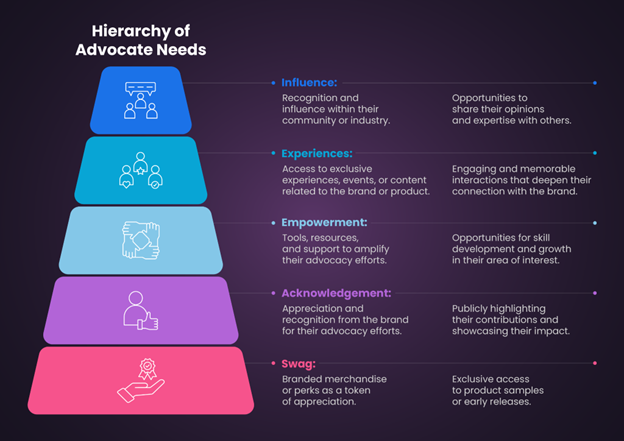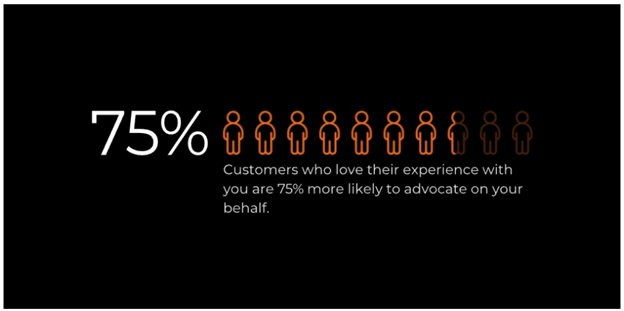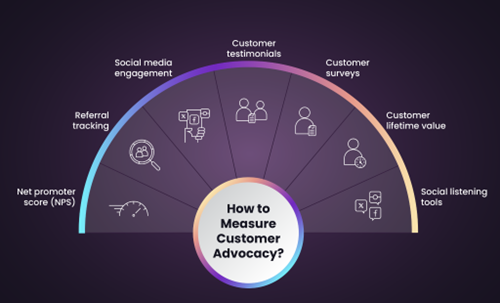Customer advocacy is a powerful marketing approach that focuses on nurturing loyal and satisfied customers who then become enthusiastic advocates for a brand. It involves actively engaging and empowering customers to promote a company's products or services through positive word-of-mouth, referrals, testimonials, and social media interactions.
By harnessing the influence of satisfied customers, customer advocacy aims to build brand credibility, drive customer acquisition, and enhance customer retention.
According to a recent study, 92% of consumers trust recommendations from friends and family more than any other form of advertising. Additionally, 84% of customers admit that they are more likely to trust online reviews and testimonials when making purchasing decisions.
These statistics highlight the significant impact that customer advocacy can have on a company's reputation and bottom line. By cultivating a community of satisfied customers who actively advocate for a brand, businesses can tap into the power of social proof and leverage the trust and credibility that comes with genuine customer endorsements.
What is Customer Advocacy?
Customer advocacy refers to a strategic approach where businesses focus on nurturing satisfied customers to become advocates for their brand. These advocates actively promote the company's products or services through positive word-of-mouth, referrals, testimonials, and social media interactions.
By harnessing the influence of satisfied customers, customer advocacy aims to build brand credibility, drive customer acquisition, and enhance customer retention.

What Transforms a Customer Into an Advocate?
Several factors contribute to transforming a customer into an advocate for a brand. Firstly, a positive and exceptional customer experience plays a crucial role. When customers receive excellent service, personalized attention, and a seamless buying process, they are more likely to develop a sense of loyalty and satisfaction.
Secondly, strong relationships and emotional connections with the brand can turn customers into advocates. When customers feel valued, understood, and supported, they develop a deeper affinity for the brand, leading to advocacy. Lastly, effective communication and engagement strategies foster advocacy.
Regular interactions, personalized communication, and active listening to customer feedback help build trust and loyalty, encouraging customers to become vocal advocates for the brand.
Importance of Customer Advocacy
Customer advocacy is of paramount importance for businesses due to the following reasons:
Approximately 90% of consumers state that recommendations from friends, family, or acquaintances have the greatest impact on their buying choices.

Trust and Credibility
Customer advocacy helps build trust and credibility for a brand. When satisfied customers become advocates and share their positive experiences, potential customers are more likely to trust the recommendations and testimonials of real people over traditional advertising methods.
Brand Awareness and Exposure
Customer advocacy amplifies brand awareness and exposure. Advocates actively promote the brand through word-of-mouth, referrals, and social media, reaching a wider audience and generating organic buzz that extends the brand's reach beyond its immediate customer base.
Customer Retention
Customer advocacy contributes to higher customer retention rates. Satisfied customers who become advocates are more likely to remain loyal to the brand, continue their engagement, and potentially become repeat customers, thus improving overall customer retention and reducing churn.
Competitive Advantage
Having a strong base of customer advocates gives a brand a competitive advantage. Advocates differentiate the brand from competitors by sharing their positive experiences, testimonials, and endorsements.
This creates a positive perception and preference for the brand among potential customers, helping the brand stand out in a crowded market.
Feedback and Improvement
Customer advocacy provides valuable feedback and insights for the brand's improvement. Advocates often offer suggestions, recommendations, and constructive criticism based on their experiences.
This feedback helps the brand identify areas for enhancement, address customer concerns, and drive continuous improvement in its products, services, and overall customer experience.
Building a Strategy for Customer Advocacy
Define Goals
Start by defining clear and measurable goals for your customer advocacy strategy. Determine what you aim to achieve, such as increasing referral rates, improving customer satisfaction, or boosting brand awareness. Clearly defined goals will guide your strategy and help you measure success.
Identify Your Advocate Base
Identify your existing customers who are most likely to become advocates. Look for customers who have shown high satisfaction, loyalty, and engagement with your brand. These individuals are more likely to advocate for your brand and can serve as the foundation for your advocacy program.
Cultivate Strong Relationships
Focus on building strong relationships with your customers. Provide exceptional customer experiences, personalized communication, and excellent customer support. Cultivating strong relationships creates a sense of loyalty and emotional connection, making customers more likely to become advocates.
Encourage Feedback and Engagement
Create avenues for customers to provide feedback, share their experiences, and engage with your brand. Actively listen to their suggestions and concerns and show that their opinions matter. Encouraging feedback and engagement demonstrates that you value their input, increasing the likelihood of advocacy.
Identify Advocacy Opportunities
Identify opportunities where customers can advocate for your brand. This can include referral programs, testimonials, case studies, social media campaigns, or participation in brand events. Identify channels and activities that align with your customers' preferences and encourage them to become advocates.
Provide Advocate Incentives
Consider providing incentives or rewards to motivate customers to become advocates. This can include exclusive discounts, early access to new products, loyalty rewards, or recognition programs. Incentives can boost advocacy participation and show appreciation for their support.
Measure and Track Results
Establish metrics to measure the effectiveness of your customer advocacy efforts. Track metrics such as referral rates, customer satisfaction scores, social media engagement, or brand mentions. Utilize tools and platforms that consolidate data from various sources, making it easier to measure and analyze results. Regularly evaluate the impact of your advocacy program and make adjustments as needed to optimize outcomes.
A One-Step Tool For Customer Advocacy: Arena Calibrate
A game-changing solution for customer advocacy, Arena Calibrate is a comprehensive one-step tool designed to empower businesses in cultivating and leveraging their customer advocates.
By streamlining the process and providing a range of powerful features, Arena Calibrate simplifies and enhances customer advocacy initiatives, enabling businesses to harness the full potential of their loyal advocates.
With its user-friendly interface and robust functionality, Arena Calibrate offers a seamless and efficient experience for businesses seeking to build and amplify their network of customer advocates.
From identifying and engaging advocates to measuring their impact and rewarding their efforts, Arena Calibrate is the ultimate tool for driving customer advocacy success.
Measuring Customer Advocacy
To measure the impact and effectiveness of customer advocacy efforts, businesses can utilize various metrics and tools. These include:

Net Promoter Score
NPS is a widely used metric that measures customer loyalty and advocacy. It gauges the likelihood of customers recommending a brand to others on a scale of 0 to 10. By calculating the NPS score and analyzing the distribution of promoters, passives, and detractors, businesses can assess the level of advocacy and track changes over time.
Referral Tracking
Tracking the number of referrals received from advocates provides a tangible measure of customer advocacy. By monitoring and analyzing referral data, businesses can determine the effectiveness of their referral programs and identify advocates who are actively referring others to the brand.
Social Media Engagement
Monitoring social media engagement metrics such as likes, shares, comments, and mentions can provide insights into customer advocacy. High levels of engagement indicate that customers are actively advocating for the brand by sharing content, recommending products, or defending the brand's reputation.
Customer Testimonials and Reviews
Monitoring and analyzing customer testimonials and reviews provide qualitative feedback and insights into advocacy. Positive testimonials and reviews indicate satisfied customers who are willing to publicly endorse the brand, while negative feedback can highlight areas for improvement.
Customer Surveys
Conducting surveys that specifically assess customer advocacy and likelihood to recommend can provide direct insights into advocacy levels. By including questions that gauge customers' willingness to advocate and their reasons for doing so, businesses can measure and track customer advocacy over time.
Customer Lifetime Value (CLV)
Tracking CLV helps measure the long-term value generated by customer advocacy efforts. Advocates tend to have higher CLV as they generate more repeat business and referrals, contributing to increased revenue and profitability.
Social Listening Tools
Utilizing social listening tools allows businesses to monitor online conversations and sentiment related to their brand. By tracking mentions, sentiment, and themes in social media conversations, businesses can gauge the level of advocacy and identify brand advocates.
Conclusion
Customer advocacy is a powerful marketing strategy that focuses on nurturing satisfied customers to become enthusiastic advocates for a brand. By leveraging their positive word-of-mouth, referrals, testimonials, and social media interactions, customer advocacy helps build trust, increase brand awareness, drive customer retention, gain a competitive advantage, and gather valuable feedback.
Through a well-defined strategy that includes setting goals, identifying advocates, cultivating relationships, encouraging engagement, identifying opportunities, providing incentives, and measuring results, businesses can harness the influence of their satisfied customers and turn them into brand advocates.
By amplifying the voice of these advocates, businesses can create a ripple effect of positive experiences and recommendations, ultimately leading to business growth and success.
FAQs on Customer Advocacy
What is an example of customer advocacy?
An example of customer advocacy is when a satisfied customer voluntarily shares their positive experience with a brand and actively promotes it to others. For instance, imagine a customer who recently purchased a smartphone and had an exceptional experience with the product and the customer service provided by the company.
Impressed by the quality and performance of the smartphone, this customer decides to write a glowing review on the company's website, share their positive experience on social media platforms, and recommend the brand to their friends and family.
They may even participate in online forums or communities, answering questions and offering advice to potential buyers. This customer's voluntary advocacy creates a positive buzz around the brand, influencing others' purchase decisions and enhancing the brand's reputation.
How does social media listening increase customer advocacy?
Social media listening plays a crucial role in increasing customer advocacy by providing businesses with valuable insights and opportunities to engage with customers. Here's how social media listening can enhance customer advocacy:
- Identifying Advocates: Social media listening allows businesses to identify customers who are actively advocating for their brand. By monitoring conversations, mentions, and tags related to the brand, businesses can spot customers who consistently express positive sentiments, share experiences, and recommend the brand to others. Recognizing these advocates enables businesses to nurture and amplify their advocacy efforts.
- Engaging with Advocates: Social media listening enables businesses to proactively engage with advocates, acknowledging their support and expressing appreciation. Responding to their posts, comments, and messages demonstrates that their advocacy is valued. By engaging with advocates, businesses can foster a sense of loyalty and strengthen the relationship, leading to continued advocacy and positive word-of-mouth.
- Resolving Issues: Social media listening allows businesses to identify and address any concerns or issues raised by customers. Promptly responding to customer queries, complaints, or feedback shows that the brand values its customers' opinions and is committed to delivering excellent service. Resolving issues effectively can turn dissatisfied customers into advocates as they witness the brand's responsiveness and dedication to customer satisfaction.
- Content Generation: Social media listening helps businesses understand the topics, trends, and interests that resonate with their audience. By analyzing conversations and discussions, businesses can gather insights on what type of content would be valuable and engaging for their advocates. This knowledge can inform the creation of relevant and compelling content, such as blog posts, videos, or infographics, which advocates can share with their networks, expanding brand reach and advocacy.
- Identifying Opportunities: Social media listening allows businesses to uncover opportunities for advocacy campaigns or initiatives. By monitoring relevant hashtags, industry conversations, or trending topics, businesses can identify moments where their advocates can contribute, share their experiences, or provide testimonials. Leveraging these opportunities effectively can amplify the advocacy message and attract new customers.
- Overall, social media listening provides businesses with real-time insights, enabling them to understand their customers, engage with advocates, address concerns, generate compelling content, and identify advocacy opportunities. By leveraging these insights and taking appropriate actions, businesses can foster customer advocacy and harness the power of social media to amplify their brand's reach and reputation.
What is the best description of customer advocacy?
Customer advocacy is a strategic approach in which satisfied and loyal customers actively promote a brand by sharing positive experiences, providing referrals, writing testimonials, and engaging in word-of-mouth recommendations.
It involves harnessing the power of satisfied customers to build trust, increase brand awareness, drive customer acquisition and retention, and gain a competitive advantage. Customer advocacy goes beyond traditional marketing efforts, relying on the genuine enthusiasm and advocacy of customers to influence others and create a positive reputation for the brand.
How can you utilize brand advocates?
To effectively utilize brand advocates, consider the following strategies:
- Engage and nurture relationships: Actively engage with brand advocates by acknowledging their support, responding to their feedback, and building strong relationships. Show appreciation for their advocacy efforts and maintain regular communication to strengthen the bond.
- Provide exclusive benefits: Offer exclusive benefits or incentives to brand advocates as a token of appreciation. This can include early access to new products, special discounts, personalized offers, or access to VIP events. By providing these perks, you reinforce their loyalty and motivate them to continue advocating for your brand.
- Encourage user-generated content (UGC): Encourage brand advocates to create and share user-generated content that highlights their experiences with your brand. This can include testimonials, reviews, social media posts, or videos. UGC serves as authentic and persuasive content that can attract new customers and reinforce the positive reputation of your brand.
- Leverage social media platforms: Utilize social media platforms to amplify the reach of brand advocates. Encourage them to share their experiences, tag your brand, and use relevant hashtags. Repost or retweet their content to showcase their advocacy and expose it to a wider audience.
- Facilitate referrals: Implement a referral program that rewards brand advocates for referring new customers. Provide them with personalized referral links or codes that they can share with their network. Incentivize both the advocate and the new customer to encourage participation and drive referrals.
- Seek input and feedback: Involve brand advocates in product development, beta testing, or customer advisory boards. Their insights and feedback can provide valuable guidance for improving products or services. This involvement also reinforces their sense of importance and strengthens their connection with the brand.
- Create opportunities for advocacy: Identify opportunities where brand advocates can represent your brand, such as speaking engagements, webinars, or guest blogging. Provide platforms and resources for them to share their expertise and experiences, positioning them as thought leaders and further enhancing their advocacy.
- Share success stories: Highlight the success stories and experiences of brand advocates through various channels, including your website, social media, email newsletters, or case studies. By showcasing their positive experiences, you not only recognize their support but also inspire others to become advocates themselves.
Remember, building and nurturing relationships with brand advocates is an ongoing process. Continuously communicate with them, provide support, and create opportunities for them to stay engaged and connected to your brand.
What is B2B customer advocacy?
B2B customer advocacy refers to the practice of nurturing and leveraging satisfied customers in the business-to-business (B2B) context to promote a company's products or services. It involves engaging and empowering B2B customers to become advocates who actively recommend and endorse the brand to other businesses or professionals within their network.
In B2B customer advocacy, satisfied customers serve as trusted references and sources of credibility for prospective clients. They may provide testimonials, case studies, or participate in referral programs to showcase their positive experiences with the brand. B2B customer advocates can play a significant role in influencing purchase decisions, building trust, and enhancing the reputation of the brand among potential clients.
B2B customer advocacy is particularly relevant in industries where relationships, trust, and reputation hold significant importance. By cultivating strong relationships with customers, actively seeking their feedback, and leveraging their advocacy, B2B companies can strengthen their position in the market, drive customer acquisition, and foster long-term business growth.




